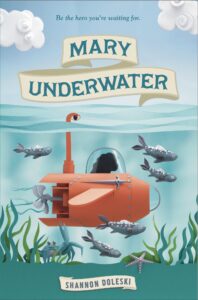
Mary Underwater
Shannon Doleski
Amulet
Published April 7, 2020
Amazon | Barnes & Noble | Book Depository | Indiebound | Goodreads
About Mary Underwater
Mary Murphy feels like she’s drowning. Her violent father is home from prison, and the social worker is suspicious of her new bruises. An aunt she’s never met keeps calling. And if she can’t get a good grade on her science project, she’ll fail her favorite class.
But Mary doesn’t want to be a victim anymore. She has a plan: build a real submarine, like the model she’s been making with Kip Dwyer, the secretly sweet class clown.
Gaining courage from her heroine, Joan of Arc, Mary vows to pilot a sub across the Chesapeake Bay, risking her life in a modern crusade to save herself.
Mary Underwater is an empowering tale of persistence, heroism, and hope from a luminous new voice in middle-grade fiction.
My Review
Special thanks to Dahlia Adler from LGBTQReads for inviting authors to list their debut novels in a thread on her Twitter account, which I think is how I learned about this book.
The cover and description of MARY UNDERWATER totally had me hooked. I am super interested in stories that show young women and STEM, and a girl building a submarine seemed too cool to pass up.
This book has so many things I love. I love Mary’s character. The way her timidity blossoms into confidence. The celebration of St. Joan of Arc both in her narrative and in biographical snippets between chapters. I love the relationships between Mary and her teachers, Sister Eu and Mr. Fen, and her mentor, Ford. I love the way her aunt steps into her life, building a safe relationship, and encouraging Mary, but also talking straight.
I read MARY UNDERWATER in one sitting because I couldn’t stop. Without meaning to, I pretty much one-more-chaptered myself all the way to the end and I have zero regrets about that. It’s a heartwarming, inspiring story, with a strong, positive representation of both women and faith. I don’t think I’ve ever seen that combination done so well before, and I really, truly loved it.
I think readers who enjoyed THE QUEEN BEE AND ME by Gillian McDunn or CHIRP by Kate Messner absolutely need to read this one.
Content Notes
Recommended for Ages 10 to 14.
Representation
Mary’s aunt has a female partner.
Profanity/Crude Language Content
References to cursing.
Romance/Sexual Content
Brief kissing between boy and girl.
Spiritual Content
Mary attends a Catholic school and makes lots of references to the nuns praying. She also takes courage from the story of St. Joan of Arc and imagines herself being brave as she was. Mary prays the Hail Mary prayer while distressed.
Violent Content – Possible trigger warning for domestic violence
Mary and her mother have bruises from her father abusing them. The abuse happens off-scene. Her father also breaks something important to Mary and attacks one of her friends. (Both these incidents happen off-scene.)
Drug Content
Mary’s dad drinks a lot of alcohol.
Note: This post contains affiliate links, which do not cost you anything to use, but which help support running this blog.